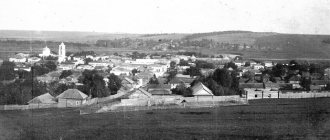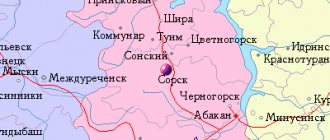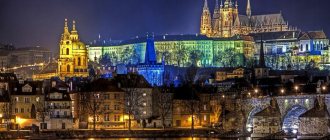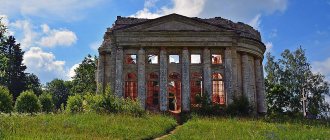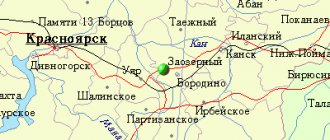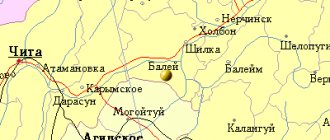Assumption Cathedral
The history of the Assumption Cathedral is not just connected with the history of the city of Yaransk - it actually began with it. The place where the temple now stands can well be called the heart of Yaransk, from which, like a life-giving circulatory system, streets with residential buildings and outbuildings stretch. This is how the whole organism arose, and in its center is the Cathedral of the Assumption of the Blessed Virgin Mary.
Today this temple is the center of the deanery of the Southern District of the Iranian Diocese. And if ordinary townspeople are accustomed to colloquially calling it the Assumption Church, and parishioners call it the Cathedral of the Assumption of the Blessed Virgin Mary, then for the clergy it is, first of all, a cathedral.
Versions of the origin of the name of the city of Yaransk
In the southwest of the Vyatka land, on the high right bank of the Yaran River, stands the city of Yaransk.
The origin of the name of the city of Yaransk has several versions. The most common of them is presumably named after the Yarani River, in the basin of which since the beginning of the 1st millennium AD. e. lived the Finno-Ugric tribe Yar. In addition, the Mari word “yara” or “yaran” called something empty, not occupied by anyone, for example, the land where the Cheremis settled since ancient times. According to another assumption, this name could come from the Russian dialect “yaran” or “eran”, taken from the language of the local Komi people and denoting the Khanty, some tribes of the Mansi and Nenets.
Trinity Church is the largest in the area
The true pride of Yaransk has always been the largest and richest in decoration and interior decoration of the Trinity Church. It was built according to the drawings of the famous architect Konstantin Andreevich Ton, according to whose design the Cathedral of Christ the Savior was built in Moscow, in the Russian-Byzantine style.
The original building of the Trinity Church with a bell tower was consecrated back in October 1694, but after a century and a half it had become quite dilapidated, and restoration could no longer save it. In 1844, the old church was dismantled, saving only the bell tower, and the best materials were used in the construction of the new church, which began a year later.
In 1857, the magnificent building was completed and solemnly consecrated. Since the old bell tower was preserved all this time, the construction of the new one took a long time. Only by 1889 the New Trinity Bell Tower was ready and, together with the Trinity Church, which had eight chapels, formed a single complex.
The new Trinity Church with a bell tower was erected largely thanks to the generous help of patrons. The total cost of construction was 23,817 rubles 99.5 kopecks. It is known that the merchant of the 1st guild, I. V. Lesnikov, alone donated 15,000 rubles in banknotes to the church and sent to the church the Holy Gospel, worth 1,700 rubles and weighing 14.33 kilograms. And the city merchant Kuzma Belyaev, who knew Alexander Herzen and supplied Vyatka libraries with books, even managed to obtain drawings for the temple from the architect Ton and bring them to Yaransk.
Since the 30s of the last century, the Trinity Church housed a warehouse, and then a bakery and boiler room; This may be why there were repeated fires in the building. Only in 1998 the temple was handed over to believers, and in the summer, on the eve of the patronal feast of the Life-Giving Trinity, the first service of the All-Night Vigil was solemnly held here. In 1998, the church received the status of a cathedral, and since 2015 it houses the relics of St. Matthew of Iran.
First a prison, then a hail!
According to legend, having initially stopped on a high ravine on the right bank of the Yaran, the Russian soldiers decided to move the future city beyond a wide ravine, closer to the former Mari settlement there, since from there “it smelled of milk and baked bread,” and the place was already inhabited. At the site they abandoned, a monastery was subsequently organized.
The construction of Yaransk began on the site of the current Assumption Cathedral. It was chosen well: the rapidly growing fortress-fortress, surrounded by log walls, was protected by a deep ravine in the south, river waters in the west, and impassable forest thickets in the east. For many years, forts of this kind were built throughout Russia: a high wooden palisade with strong gates with bolts, towers with loopholes, fortress and service buildings, a hut that served as the voivodeship office of the governor, and a mandatory church - in Yaransk it was the Assumption.
In the 17th century there was a strong garrison here, which gave rise to the Streltsy settlement on the banks of the Yaran. At that time, Yaransk was primarily a military settlement: several times more service people lived here than townspeople. The city settlement was located next to the Streltsy settlement and quickly grew due to new settlements of traders and artisans. Later, two monasteries were founded nearby, the male monastery - Voznesensky and the female monastery - Vladimirsky. Next to them ran a busy “highway” road from Moscow to the Urals.
Novo-Troitskaya Bell Tower
The New Trinity bell tower of the Trinity Church dates back to 1878, but all work was completed only by 1889. It is designed in the style of the Moscow Kremlin towers and rises to 66.5 meters. It offers a magnificent view of Yaransk and the city surroundings. Before the revolution, the Yaranichs used it to find out the time: the largest of the more than two dozen bells of the Trinity Belfry, weighing over two tons, regularly chimed the hours.
The construction of the five-tier bell tower was completed much later than the temple itself, so its architecture has certain artistic differences from the canons of the Russian-Byzantine style, but at the same time it forms an integral architectural ensemble with the church building.
For a long time, the bell tower was deprived of a cross, cut down and thrown to the ground during the years of militant atheism in the country. At the base of the lost shrine, a memorial inscription discovered by restorers has been preserved: “Forged on August 25, 1878.” Thanks to a gift from philanthropist Nikolai Ivanovich Sushentsov, on November 4, 2001, the bell tower acquired a new beautiful cross. The Yaran newspaper “Fatherland” wrote about this: “Sunday November 4th is the day of veneration of the Mother of God for her intercession... the fruit of three years of effort - the cross - was delivered to us from the Republic of Mari El. Prayer services were held in churches dedicated to the Mother of God, and in Trinity - the erection of the cross on the New Trinity bell tower. Then there was its consecration, a religious procession to the place of ascension. The entire operation of hoisting the cross on the top of the bell tower took place with bated breath from the people gathered around, as the steeplejacks worked without insurance. And at noon the cross shone over our dear homeland, the city of Yaransk, thereby signaling that we must get rid of the power of evil.”
Population[ | ]
| Population | |||||||||
| 1856[8] | 1897[8] | 1926[8] | 1931[8] | 1939[8] | 1959[9] | 1970[10] | 1979[11] | 1989[12] | 1992[8] |
| 2600 | ↗4800 | ↗6100 | →6100 | ↗9300 | ↗11 768 | ↗15 374 | ↗17 756 | ↗20 466 | ↗20 700 |
| 1996[8] | 1998[8] | 2000[8] | 2001[8] | 2002[13] | 2003[8] | 2005[8] | 2006[8] | 2007[8] | 2008[14] |
| ↗21 400 | ↗21 500 | ↗21 700 | →21 700 | ↘19 723 | ↘19 700 | ↗19 800 | →19 800 | ↘19 700 | →19 700 |
| 2009[15] | 2010[16] | 2011[8] | 2012[17] | 2013[18] | 2014[19] | 2015[20] | 2016[21] | 2017[22] | 2018[23] |
| ↘19 690 | ↘17 253 | ↗17 300 | ↘16 930 | ↘16 721 | ↘16 624 | ↘16 460 | ↘16 283 | ↘16 106 | ↘15 985 |
| 2019[24] | 2020[25] | 2021[1] | |||||||
| ↘15 752 | ↘15 475 | ↘15 279 | |||||||
As of January 1, 2021, in terms of population, the city was in 771st place out of 1,116[26]cities of the Russian Federation[27].
According to the Administration of the Yaransky Municipal District, the population of the Yaransky urban settlement in 2021 was 25,421 people; in 2021 25,240 people.
“Yaranskaya Candle” – Old Trinity Bell Tower
The townspeople call it the Yaranskaya Candle, wits have long called it the “broken pencil,” but its original name is the Old Trinity Bell Tower.
The fact that after the dismantling of the old building of the Church of the Life-Giving Trinity its bell tower survived seems surprising today. According to one version, the architect of the new temple, Konstantin Ton himself, petitioned the church and secular authorities in order to preserve this extraordinary and very significant monument of ancient architecture from the point of view of the architecture of the Vyatka region. His opinion was listened to and supported.
But there is also a legend that the bell tower of the old church was preserved by its very wealthy parishioners - the Yaran merchant families of the Nosovs and Unzhenins. They wanted to leave the old bell tower in memory of their temple. The request of generous benefactors who invested a lot of money in the new temple was respected.
One way or another, one of the most ancient buildings in Yaransk (between 1670-1690) has survived to this day. According to the legend that always accompanies buildings of such advanced years, a certain young Cheremis pagan was allegedly walled up at the base of this bell tower as punishment for trying to interfere with the construction of the first Trinity Church. Also in the past there was a legend about an underground passage under the old bell tower, but no evidence of this was found.
History has not preserved the names of the bell tower's builders, but one cannot help but pay tribute to the art of the unknown masters who managed to create such a lasting architectural monument. Only now, according to some reports, the dome was blown away by hurricane winds during a thunderstorm in the summer of 1955.
The bell tower even managed to survive the years of Soviet rule, when almost all church buildings in Russia were used for other purposes. The regular octahedron at the base of the 40-meter tent tower in five tapering tiers invariably arouses the admiration of tourists.
Today, the “Yaranskaya Candle” is the only representative of the Moscow (Naryshkin) baroque in the architecture of the Vyatka region. According to archival data, by the beginning of the 19th century, 10 bells were still preserved in its belfry, the sound of which spread throughout the entire area.
On October 18, 1924, the Old Trinity Bell Tower was included in the list of monuments of church architecture of the Vyatka province, registered by the Department for Museum Affairs of the Main Science of the People's Commissariat of Education of the RSFSR. It is in dire need of careful care and strengthening of the entire building, whose age has already exceeded three centuries.
Its amazing silhouette is an integral part of the citywide panorama of Yaransk, and it would be extremely unwise to lose it.
Foundation of the city
At first, a fortified settlement was founded here in a series of small fortified towns. They were built in the Kazan governorate to protect the new borders of the Russian northeast, especially after the 3rd Cheremis War.
The official date of the foundation of Yaransk is considered to be 1584, and local historians also talk about an earlier dating of the first local settlements. The main and, in fact, the only evidence of this is information from the Vyatka Vremennik. This chronicle, dating from the last quarter of the 17th century, describes events up to 1700. The compilers, deacon of the Epiphany Cathedral in the city of Khlynov, Semyon Popov and his son Ivan, wrote down:
“In the summer of March 7092 (1584), on the 19th day, an hour and a half before the evening, the sovereign Tsar and Grand Duke Ivan Vasilyevich of All Russia reposed, reigned for 31 years and expanded the Moscow state... 1588 in the same summer the cities were established: Tsarev Shanchurin, Urzhyum, a city in Samara, Yaranskaya..."
Not considering this evidence as a direct chronicle source, some scientists and researchers associate the founding of Yaransk with 1591. At the same time, they date the earliest documentary evidence, in particular, information about the clerks at the head of the Yaran administration, to 1594.
Water "lock"
Those who come to Yaransk for the first time are often surprised: where does such a beautiful ancient castle come from in this city and who did it belong to? And their admiration grows when they learn that this colorful red brick tower is in fact just a tower, and also a water tower.
Indeed, once upon a time in our cities even such utilitarian structures resembled genuine works of architectural art. And this was only a century ago: the water tower at the intersection of Khalturin and Nekrasov streets was erected in 1912. Previously, a city water supply system was built using funds from the local government - the zemstvo - and donations from Yaran merchants. The sons of the merchant Alexander Petrovich Kalinin and the merchant Fyodor Yakovlevich Roshchin in 1911 donated large sums of money to the city that were missing for its construction.
Thanks to this, they built a water pumping station and a pressure tower, and also laid a water main, placing 7 water booths, 4 standpipes and 32 fire wells on three of the then 15 streets of the city. A power station was equipped in the water pumping building, which illuminated the Zemstvo Administration and some nearby houses in the evening. Then the city was telephoned, and the first devices were installed, including at the water pumping station, connecting it with a quick connection to the city council and the fire station.
This seemingly purely technical structure greatly beautified Yaransk, becoming its architectural landmark. Nowadays it is not used for its intended purpose; local cable television equipment is located here. However, the VKontakte social network group “Water Towers of Russia”, specially created by residents of St. Petersburg, also placed the Yaransk “castle” in its collection of the same name.
Climate[ | ]
The climate is temperate continental.
Climate of Yaransk (norm 1981—2010)
| Index | Jan. | Feb. | March | Apr. | May | June | July | Aug. | Sep. | Oct. | Nov. | Dec. | Year |
| Average temperature, °C | −11,5 | −11,3 | −5 | 4,1 | 11,5 | 16,6 | 18,9 | 15,9 | 10,1 | 3,6 | −4,2 | −9,3 | 3,3 |
| Precipitation rate | 36 | 28 | 30 | 31 | 42 | 68 | 76 | 63 | 56 | 54 | 43 | 37 | 564 |
| Source: [7]. | |||||||||||||
Shopping arcades – House of Folk Art
From the same Nosovs, the city at one time bought the building of the current regional House of Folk Art, in common parlance - the local House of Culture, which is also called the Leisure Center. Previously, this merchant family located their trading rows here. Their creator was the famous provincial architect Filimon Roslyakov, who designed the Cathedral of the Assumption of the Virgin Mary in Yaransk. This building also partly resembles a church temple in its appearance.
Since then, the Trading Rows have been rebuilt several times, and under Soviet rule, in 1924, they were given over to a club organized in the city and in 1927 they were significantly refurbished. Then the building was transferred to a variety of organizations, from a granary and a sports ground to a beer store and a film distribution service.
After a radical reconstruction in the 1950s, it acquired a modern look and again became a cultural institution. Among the attractions of the district House of Folk Art is an original chandelier, made to special order in Armenia (1956), and the oldest People's Theater in the district, which has been fruitfully working here since 1959. In addition, the former Trading Rows today also house shops, as well as a computer club and a game library.
Notable prisoners of the Yaransk prison
Despite direct communication, getting to provincial Yaransk for the capital's nobles was tantamount to disgrace and exile. For some, imprisonment here turned out to be quite real. In 1619, the first royal bride, Maria Khlopova, was sent here, who fell victim to palace intrigues. And earlier, in 1601, the uncle of her failed fiancé, the first Russian Tsar Mikhail Fedorovich, the noble Moscow boyar Vasily Nikitich Romanov, was already imprisoned here. He, as a representative of a family that was actively laying claim to the throne, was expelled from Moscow by Boris Godunov, who was mortally afraid of the strong boyar opposition. Vasily Romanov was kept in the city for a month and a half, according to some sources, in steel shackles, after which he was sent further to the Urals. From that time on, the hill in the central part of the city, where the exiled boyar stayed, was called Romanovskaya Mountain, and the deep place of his bathing on Yaran - Romanovskaya Pit.
Public transport[28][ | ]
There are two city bus routes:
- Avtokombinat 1853 - PMK 399 - Poultry farm - st. Revolutions - st. Karl Marx - Museum - School No. 2 - Market - School No. 3 - RMZ - st. Young Guard - Dry cleaning - Vodka plant - Pervomaiskaya - DSU-5 - Sokoly.
- Distillery - Zavodskaya - Elevator - Lagunovskaya - st. Revolutions - st. Karl Marx - Museum - School No. 2 - Market - School No. 3 - RMZ - st. Young Guard - Dry cleaning - Vodka plant - Pervomaiskaya - DSU-5 - Sokoly.
Ten commuters:
- Yaransk — Znamenka
- Yaransk - Verkhouslino - Salobelak
- Yaransk - Lom - Ryzhakovo
- Yaransk — Pervomaisk
- Yaransk – Savichi – Pushkino
- Yaransk — Nikulyata
- Yaransk — Rozhdestvensk
- Yaransk - Salobelak - Engener
- Yaransk — Urtma
- Yaransk - Sosnovka - Bibikovo (Seasonal)
Notes[ | ]
- ↑ 12
The permanent population of the Russian Federation by municipalities as of January 1, 2021 (Russian). Date accessed: April 27, 2021. Archived May 2, 2021. - Estimated resident population at the beginning of the year (unspecified)
(inaccessible link). kirovstat.gks.ru. Date accessed: April 9, 2019. Archived May 6, 2021. - Smirnov O. V.
On the issue of the Permian toponymic substrate on the territory of Mari El and in the basin of the middle reaches of the Vyatka River (in the light of the ethnic interpretation of archaeological cultures). 2 // Questions of onomastics. 2014. No. 1 (16). C. 12. - / No. 37, p. 75 /.
Villages of Simbirsk district.
IV. Yazykovskaya volost (undefined)
. archeo73.ru. Date accessed: December 24, 2021. - Shamshurenkov Leonty Lukyanovich // Great Soviet Encyclopedia: [in 30 volumes] / ch. ed. A. M. Prokhorov. — 3rd ed. - M.: Soviet Encyclopedia, 1969-1978.
- Law of the Kirov Region dated December 7, 2004 No. 284-ZO “On establishing the boundaries of municipalities of the Kirov Region and granting them the status of a municipal district, urban district, urban settlement, rural settlement”
- FSBI "VNIIGMI-MCD".
- ↑ 1 2 3 4 5 6 7 8 9 10 11 12 13 14 15
People's Encyclopedia “My City”.
Yaransk (undefined)
. Access date: December 15, 2013. Archived December 15, 2013. - All-Union Population Census of 1959. The size of the urban population of the RSFSR, its territorial units, urban settlements and urban areas by gender (Russian). Demoscope Weekly. Access date: September 25, 2013. Archived April 28, 2013.
- All-Union Population Census of 1970 The size of the urban population of the RSFSR, its territorial units, urban settlements and urban areas by gender. (Russian). Demoscope Weekly. Access date: September 25, 2013. Archived April 28, 2013.
- All-Union Population Census of 1979 The size of the urban population of the RSFSR, its territorial units, urban settlements and urban areas by gender. (Russian). Demoscope Weekly. Access date: September 25, 2013. Archived April 28, 2013.
- All-Union population census of 1989. Urban population (undefined)
. Archived from the original on August 22, 2011. - All-Russian population census 2002. Volume. 1, table 4. Population of Russia, federal districts, constituent entities of the Russian Federation, districts, urban settlements, rural settlements - regional centers and rural settlements with a population of 3 thousand or more (unspecified)
. Archived from the original on February 3, 2012. - Cities of the Kirov region (number of inhabitants - estimate as of January 1, 2008, thousand people) (unspecified)
. Date accessed: June 12, 2021. Archived June 12, 2016. - The size of the permanent population of the Russian Federation by cities, urban-type settlements and regions as of January 1, 2009 (unspecified)
. Retrieved January 2, 2014. Archived January 2, 2014. - Population census 2010. Population of Russia, federal districts, constituent entities of the Russian Federation, city districts, municipal districts, urban and rural settlements (Russian). Federal State Statistics Service. Access date: December 16, 2013. Archived April 28, 2013.
- Population of the Russian Federation by municipalities. Table 35. Estimated resident population as of January 1, 2012 (unspecified)
. Retrieved May 31, 2014. Archived May 31, 2014. - Population of the Russian Federation by municipalities as of January 1, 2013. - M.: Federal State Statistics Service Rosstat, 2013. - 528 p. (Table 33. Population of urban districts, municipal districts, urban and rural settlements, urban settlements, rural settlements) (undefined)
. Retrieved November 16, 2013. Archived November 16, 2013. - Table 33. Population of the Russian Federation by municipalities as of January 1, 2014 (unspecified)
. Access date: August 2, 2014. Archived August 2, 2014. - Population of the Russian Federation by municipalities as of January 1, 2015 (unspecified)
. Access date: August 6, 2015. Archived August 6, 2015. - Population of the Russian Federation by municipalities as of January 1, 2021 (Russian) (October 5, 2018). Date accessed: May 15, 2021. Archived May 8, 2021.
- Population of the Russian Federation by municipalities as of January 1, 2021 (Russian) (July 31, 2017). Retrieved July 31, 2021. Archived July 31, 2021.
- Population of the Russian Federation by municipalities as of January 1, 2021 (Russian). Retrieved July 25, 2018. Archived July 26, 2021.
- Population of the Russian Federation by municipalities as of January 1, 2021 (Russian). Date accessed: July 31, 2019. Archived May 2, 2021.
- Population of the Russian Federation by municipalities as of January 1, 2021 (Russian). Date accessed: October 17, 2021. Archived October 17, 2021.
- taking into account the cities of Crimea
- https://rosstat.gov.ru/storage/mediabank/bul_Chislen_nasel_MO-01-01-2021.rar Population of the Russian Federation by municipalities as of January 1, 2021 (1.85 Mb, 07/30/2021)
- Schedule of passenger route transportation - Municipal formation Yaransky municipal district of the Kirov region
- Culture (undefined)
. Official website of the Yaransky district administration. - Wheel extravaganza in Yaransk (unspecified)
. State TV and Radio Broadcasting Company "Vyatka". - Interregional festival "Wheel Extravaganza", dedicated to the memory of Leonty Lukyanovich Shamshurenkov (unspecified)
. Official website of the Federal Tourism Agency. - Glinishek. Yaranskaya Land
